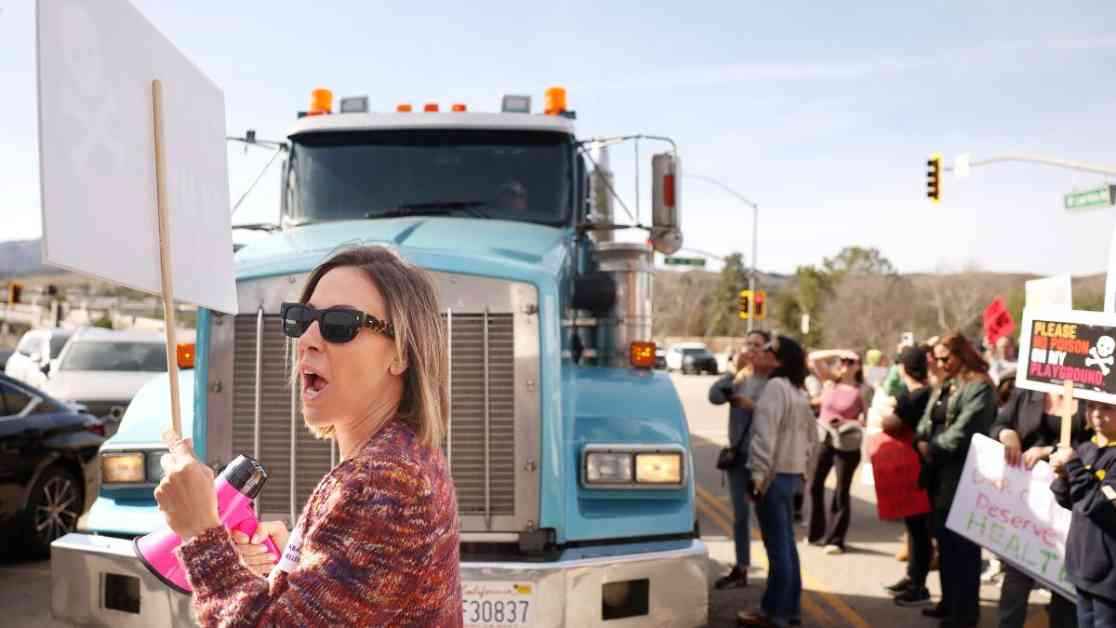In a small unincorporated area of Agoura, a scene unfolded that captured the essence of community activism and environmental concern. The Palisades fire, which ravaged the area, left behind a trail of debris and ash that was being transported to the nearby Calabasas Landfill. Kelly Martino, a local resident, took a stand against this flow of potentially toxic waste, determined to halt its entry into the landfill.
Martino was not alone in her efforts. Alongside several dozen protestors, she chanted “Back it up!” and brandished signs that read “No Toxic Dumping.” The crowd’s energy was palpable as they remained steadfast in their resolve, even in the face of potential arrests. The protestors, led by Martino, were driven by a deep-seated concern for the health and well-being of their community.
The protesters’ fears were not unfounded. There was a looming threat that the ash, debris, and soil being deposited in the landfill could contain toxic chemicals that might pose a risk to the surrounding neighborhoods. Their demand was clear – redirect the waste to landfills equipped to handle hazardous materials, with stringent safety measures in place.
As the protests gained momentum, similar demonstrations cropped up in other locations affected by the wildfires. The residents were united in their call for greater accountability and transparency in the disposal of disaster debris. The need for proper testing and oversight was paramount, especially in light of previous findings that wildfire ash contained hazardous levels of toxic chemicals.
The tension between federal officials and community activists underscored the complexity of the situation. While federal authorities maintained that the local landfills were equipped to handle the debris safely, the residents were not convinced. The risk of airborne dust carrying toxic chemicals into their neighborhoods was a genuine concern that could not be overlooked.
In Granada Hills, residents near the Sunshine Canyon Landfill voiced similar apprehensions about the potential health hazards posed by the influx of fire debris. The strong winds in the mountain pass heightened fears of toxic dust and ash being dispersed into the surrounding communities. The residents’ worries were compounded by the profit-driven motives of some landfill owners, who stood to gain substantially from accepting the massive quantities of debris.
As the protests persisted, elected officials began to take notice of the growing discontent among their constituents. Los Angeles City Councilman John Lee led the charge in calling for legal action to halt the dumping of wildfire debris at Sunshine Canyon, citing concerns about inadequate testing. The approval of his motion signaled a small victory for the community members who had been tirelessly advocating for their safety.
Despite the pushback from local officials and community activists, some landfill representatives maintained that their facilities were well-equipped to handle the incoming fire debris. However, the lack of transparency and communication surrounding the disposal process continued to fuel public outrage. Residents felt left in the dark, with no comprehensive list of landfills accepting the debris or the routes used for transportation.
The power of community activism was on full display at the Calabasas Landfill, where protestors successfully blocked a truck carrying fire debris. The collective effort led to a temporary pause in debris shipments, pending further discussions at the L.A. County Board of Supervisors meeting. The sense of solidarity and determination among the residents was unwavering, as they banded together to protect their community from potential harm.
As the dust settled, and the echoes of protest faded into the background, one thing was clear – the residents of these affected areas were not willing to compromise when it came to the safety of their neighborhoods. Their voices had been heard, their concerns acknowledged, and their fight for environmental justice was far from over. The battle to safeguard their communities from toxic debris continued, fueled by a shared commitment to creating a safer, healthier future for all.


